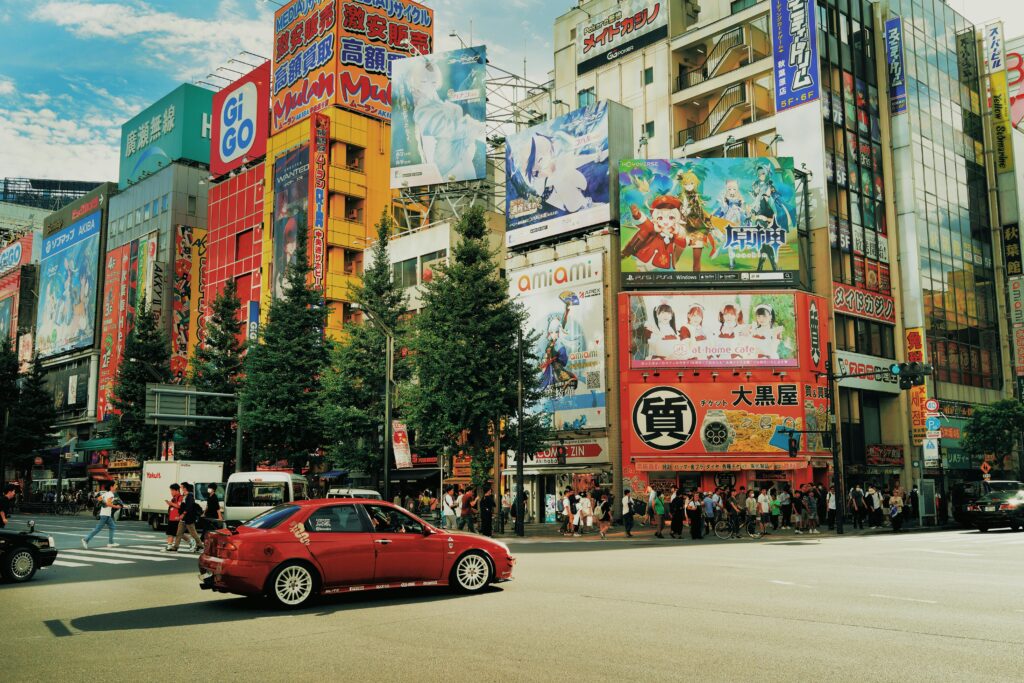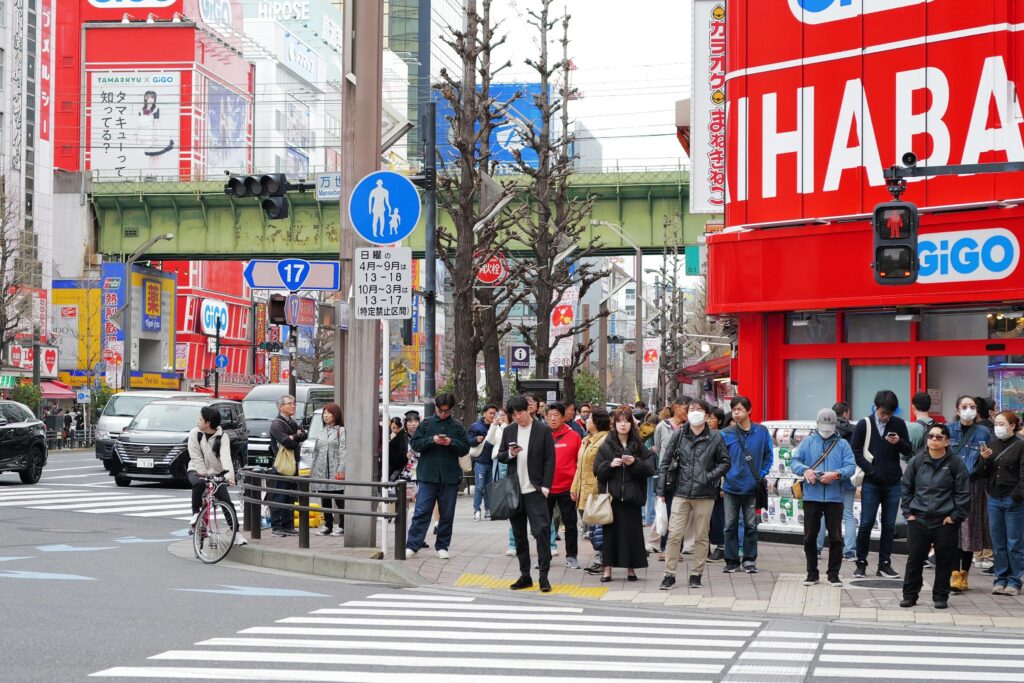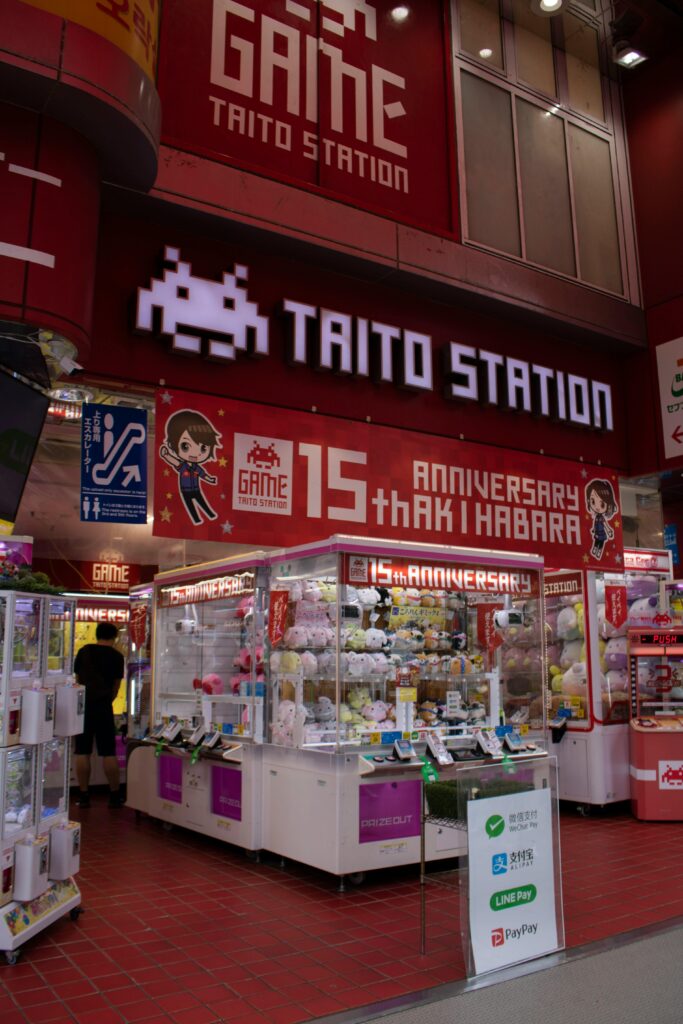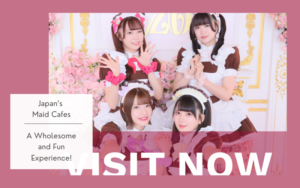Ready to insert a coin and level up your Tokyo adventure? If you’re an anime lover, a nostalgic gamer longing for the 8-bit days, or a first-time traveler looking for a uniquely geeky experience, Akihabara arcades are a must-visit. In this fun and friendly travel guide, we’ll explore Japan’s arcade culture and answer your burning questions. Grab your bag of 100-yen coins, tune your ears to the sound of retro game music, and let’s dive into the neon-lit world of Akihabara’s arcades!
Akihabara has much more than arcades. Check out our Ultimate Akihabara Guide for everything Electric Town has to offer.
Table of Contents
Are Arcades Still a Thing in Japan?
Yes! Arcades are very much still alive in Japan – though the scene has evolved over the years. These multi-story gaming havens once dotted every city, and while their numbers have declined (over 8,000 arcades closed in the last decade amid rising costs and the pandemic, the spirit of arcade gaming is far from dead. Major gaming companies like Sega have bowed out of the arcade business (Sega exited in 2022 after 50+ years, but new players have stepped in to keep the tradition going. In fact, over 12,000 game centers were still operating in 2019, and Tokyo neighborhoods are peppered with arcades large and small.
Walking into a Japanese arcade feels like stepping into an anime scene – bright flashing screens, catchy chiptune music, and the clink of coins. Unlike many Western arcades, Japanese game centers aren’t kiddie casinos full of ticket redemption games. There’s no ticket system and no prize counter; instead, you play for the thrill and for the prizes inside the machines. Game centers run on 100-yen coins (no tokens or swipe cards needed), and they cater to all ages – from school kids to salarymen. You’ll see college students perfecting rhythm games, couples on dates trying claw machines, and even grandpas dominating old-school Street Fighter cabinets. In other words, everyone can have fun at the arcade. And if you’ve ever threatened to flip a table in frustration – well, Japan even has an arcade game for that (yes, really)! In short, arcades are still a thing in Japan, offering a nostalgic yet modern playground for gamers.

What are Arcades in Japan Called?
In Japan, arcades are called “game centers” (ゲームセンター, gemu sentā), often shortened to “ge-sen.” So don’t be confused if a local friend asks, “Want to go to a game center?” – they mean the arcade. These game centers are essentially the same as arcades, packed with video game cabinets, claw machines, and more. The term “amusement center” is also used occasionally, but “game center” is the go-to lingo. Now you’re in the know: if you see a tall building in Tokyo plastered with anime characters and a sign that says Game Center, that’s your cue to head inside and play!
What is the Arcade City in Tokyo?
When it comes to arcades, Tokyo’s ultimate “arcade city” is Akihabara. Akihabara (秋葉原) – often nicknamed “Electric Town” – is the mecca for gamers and otaku in Tokyo. This district is world-famous for its cluster of electronics shops, anime and manga stores, maid cafés, and yes, multi-level arcades on almost every block. If you’re wondering where to find the highest concentration of game centers, Akihabara is the undisputed champion. It’s not just an arcade spot; it’s an entire neighborhood that feels designed by and for anime and gaming fans. Walk out of the JR Akihabara Station’s “Electric Town” exit and you’ll be greeted by giant billboards of game characters and the inviting glow of arcade signs. In other words, Akihabara is Tokyo’s arcade paradise – the one place you absolutely can’t skip if you love gaming.
Akihabara earned its reputation as “the arcade city” because it has several huge arcades packed into a small area. Historically, this was Sega’s turf with multiple Club Sega arcades, but recently the iconic arcades in Akihabara have been rebranded as GiGO (after a change in ownership). Don’t worry – the experience inside is still the same gamer’s paradise, with multiple floors of entertainment from crane games to fighting games. In fact, the blend of old and new is what makes Akiba special: you can play the latest cutting-edge rhythm game on one floor and then go up a level to find vintage 90s game cabinets on another.
Now that we’ve set the stage, let’s guide you through the best arcades to visit in Akihabara. Below are some top locations that will make any anime fan or retro gamer squeal with joy – from colossal arcade towers to hidden retro dens. Get ready to press start on your Akihabara arcade adventure!
Top Arcades to Visit in Akihabara
Akihabara’s arcades are often multi-level complexes, each floor offering a different flavor of fun. A pro tip for first-timers: most arcades have their claw machine (UFO catcher) games on the lower floors, and the video game cabinets (fighting, music, racing, etc.) on the higher floors. Also, keep an eye out for purikura (photo sticker booths) usually tucked in the basement or top floor. Here are the must-visit arcades in Akiba:
GiGO Akihabara (formerly Sega Arcade)

When you think of Akihabara arcades, the image that likely pops up is the famous Sega building – now rebranded as GiGO. GiGO Akihabara isn’t a single arcade but a chain of arcade buildings in the area. In 2022, Sega’s longtime game centers got a new life under GiGO, but they still deliver the same excitement. Look for the tall buildings with bold red, blue, or orange signage and anime posters – those are the GiGO arcades. The most iconic one sits right along the main street near the station, and others are scattered around Akiba’s electric streets.
Inside a GiGO arcade, prepare for sensory overload. The first floor greets you with rows of “UFO Catcher” claw machines offering plushies and figurines of popular anime characters (think Pokémon, One Piece, Demon Slayer and more). You might hear squeals of joy (or groans of defeat) as players try to snag these prizes. Crane game tip: staff can assist if you’re struggling – they might even reposition a stubborn prize for you if you ask nicely (in Japanese or with gestures). Upper floors are a gamer’s heaven: you’ll find everything from classic fighting games and shmups (shoot ’em ups), to modern rhythm games with pumping J-pop music, to immersive simulators. Each floor usually has a theme: for example, one floor might be dedicated to music and rhythm games (dance pads, drum games, even the latest Hatsune Miku rhythm machines), while another floor hosts versus fighting games and retro arcade classics.
What makes GiGO special is its legacy – you’re playing in the same legendary spots that appear in documentaries and anime about Tokyo gaming culture. Don’t miss GiGO’s collaboration events too: sometimes they decorate the arcade with themes from a current popular anime or game and offer exclusive merchandise at the prize counters. Whether you’re aiming to win a giant Rem figure from a claw machine or challenge a friend to Tekken or Street Fighter V, GiGO is a perfect starting point. Multiple GiGO branches in Akihabara ensure you won’t have to walk far to find your next game – in fact, there were three main GiGO arcade buildings (1, 3, and 5) even before a fourth reopened in 2023. Arcade hopping is totally a thing here!
Taito Station Akihabara (The Red Space Invader Building)

Another arcade giant in Akihabara is Taito Station – easily recognized by its signature red facade and the retro Space Invader logo. Taito Station Akihabara is often touted as one of the largest arcade game centers in the world, and it lives up to the hype with five floors of gaming goodness. If you spot a big red building just a few minutes’ walk from the station with a pixelated alien icon, you’ve found it.
Inside, the layout goes something like this: Basement: purikura photo booths (grab a friend and take some glammed-up kawaii photos). 1st & 2nd Floors: Wall-to-wall UFO catcher machines (yes, more claw machines!) stocked with everything from Kirby and Pokémon plushies to anime figurines. 3rd–5th Floors: An array of arcade video games – racing simulators, fighting games, shooters, and even VR games. For example, you might race in a full-size Initial D car cabinet on one floor, then head up to play rhythm games like Dance Dance Revolution or drumming game Taiko no Tatsujin on the next. They even have some quirky titles like train simulation games (Densha de GO!) and the famous table-flipping game (Cho Chabudai Gaeshi, where you literally flip a plastic table in anger – oddly satisfying!).
Taito Station is beloved by both locals and tourists, so it can get pretty lively (read: noisy!) with all the overlapping game sounds and excited chatter. It’s all part of the atmosphere. One awesome aspect for travelers: the staff at Taito Station are used to foreigners – don’t hesitate to ask for help or game recommendations (many staff speak a little English, and they’re very friendly). Also, check out the free play games near the entrance – often there’s a simple button-masher game or two set on free mode as a fun teaser while you wait or catch your breath. Overall, Taito Station is a must-visit to experience a quintessential Japanese arcade tower with a bit of everything.
Taito HEY (Hirose Entertainment Yard)
For the hardcore gaming enthusiast, Taito HEY – which stands for Hirose Entertainment Yard – is a legendary spot. This arcade is a retro gamer’s dream come true. While it’s operated by Taito as well, HEY has a slightly different vibe from the glossy Taito Station down the street. Think of HEY as the den for serious arcade fans: the lighting is a bit dimmer, the ambiance is old-school, and you might find veteran gamers (“oldies”) hogging the high-score machines well into the night
Taito HEY spans multiple floors and boasts over 300 arcade machines, including many vintage classics. Walking in, you’ll be greeted by rows of classic fighting game cabinets – Street Fighter II, King of Fighters, you name it – often with skilled players silently duking it out. The upper floors house shoot-’em-up games (if you’re into bullet-hell arcade shooters, this is the place to be) and other retro titles from the 80s and 90s. HEY is also known for its impressive collection of retro BEMANI music games and newer titles, so you get a mix of eras. True to its roots, the decor includes neon lights and old-school arcade signage, giving it a gritty charm. You might even catch an impromptu high-score competition or find rare Japan-only arcade games here.
One thing to note: the basement floor at HEY is not part of the arcade, so stick to the ground floor and above for the arcade action. If you’re an arcade connoisseur or just want to see what a “hardcore gamer’s den” looks like, don’t skip Taito HEY. It’s a blast from the past and a testament to Japan’s enduring arcade culture, complete with that nostalgic cigarette smell (though most arcades are non-smoking now) and the clack of arcade buttons being pounded at lightning speed.
Namco Akihabara (Bandai Namco Arcade)
A newcomer on the Akihabara arcade scene is the shiny Namco Akihabara game center, which opened in 2023. This arcade is Bandai Namco’s flagship in the area, and it moved into one of the former Sega buildings – bringing new life (and characters) to the block. Namco Akihabara boasts six floors of fun challenges for gamers, making it one of the tallest arcades around. Each level offers something different, and it’s a paradise especially for fans of Bandai Namco franchises.
Here’s a quick tour: In the basement, you’ll find a unique Gundam pod experience – over 40 battle pod stations let you step in and pilot giant robots in a Gundam-themed fighting game. If you’re a mecha anime fan, this is your chance to live out that Gundam pilot fantasy. The first and second floors are packed with claw machines filled with figurines and plushies of beloved characters from series like Pokémon, Dragon Ball, and One Piece. (Even by Akiba standards, Namco’s selection of prizes is impressive – Bandai Namco has access to all its own IPs, so expect exclusive prizes from their games and anime.) The third floor is dedicated mostly to rhythm games, most notably the iconic Taiko drum game Taiko no Tatsujin; you can hear the cheerful beat of taiko drums echoing as players try to hit notes in sync. One floor is a gachapon “forest” – a whole area of capsule toy machines where you can gacha for mini-toys and collectibles. And another floor focuses on trading card games (TCG) like Pokémon cards, with space to play or join events.
Namco Akihabara feels bright, new, and is very anime-centric. It competes head-to-head with the other arcades, and thanks to its diverse offerings (from video games to capsule toys to card games), it’s become a popular stop. Don’t be surprised if you see promotions or decorations for the latest Bandai Namco game release or anime. Whether you want to drum your heart out, catch an Eevee plush, or pick up a random Gundam capsule toy, Namco’s arcade has you covered on all fronts. It’s a great example of how Japan’s arcades are adapting, blending classic game machines with modern pop culture attractions.
Super Potato – Retro Game Store & Arcade
No Akihabara gaming guide would be complete without Super Potato – not a traditional arcade, but a famous retro video game shop with a secret arcade on the top floor. Super Potato is a pilgrimage site for any lover of classic games. Spread across three floors (in an older building decorated with Mario and 8-bit Luigi on the outside), this store sells everything retro: Famicom and Super Famicom cartridges, old Sega Saturns and Dreamcasts, Game Boys in every color, and tons of vintage gaming memorabilia. It’s like a museum where you can buy the exhibits.
After browsing the third and fourth floors packed floor-to-ceiling with retro games and consoles, head up to the fifth floor – the “Retro Game Arcade”. Here Super Potato delivers a cozy blast of nostalgia. The fifth floor has a vintage video game arcade with a curated collection of old-school coin-op games. You can plop down 100-yen coins to play classics like Street Fighter II, Bomberman, Final Fight, or even older titles on original arcade cabinets. The atmosphere is deliberately retro: you’ll hear the tinny music of 80s games and find CRT monitors displaying pixelated glory. Super Potato even enhances the time-travel feel by selling old-fashioned snacks and soda in glass bottles, so you can sip a fizzy pop as if you were gaming in the 1980s. The arcade collection isn’t huge compared to the big arcades outside, but it’s hand-picked for maximum nostalgia – enough to leave any classic gamer grinning ear to ear.
What makes Super Potato’s arcade special is the intimacy and authenticity. It’s often less crowded, giving you a chance to really soak in the retro vibes or challenge your travel buddies to a high-score contest on Pac-Man. The whole place smells faintly of old circuit boards (in a good way!) and is accompanied by chiptune melodies. If you grew up on NES, Sega Genesis, or even if you’re a curious younger fan of retro games, Super Potato will feel like a time machine. Don’t forget to snap a selfie with the life-size Mario statue on the stairwell, and perhaps pick up a vintage game cartridge or two as a souvenir on your way out. This is the ultimate spot for retro gaming nerds, combining shopping and arcade gameplay into one awesome experience.
Bonus Tips for Your Akihabara Arcade Adventure
- Bring plenty of 100-yen coins: Most machines cost ¥100 per play (some newer games or deluxe machines might be ¥200). You can usually find change machines inside the arcade, but it’s handy to start with a pocket full of coins. Trust us, you’ll go through them faster than you think when you’re having fun.
- Weekdays vs Weekends: If you want a slightly quieter experience or to try popular games without a long wait, go on a weekday afternoon. Weekends in Akihabara get crazy busy with locals, tourists, and sometimes cosplay events. The energy on a weekend is high, which can be fun, but expect crowds around popular machines.
- Arcade etiquette: Generally, it’s polite to yield the machine after you’ve had a few turns if someone is waiting behind you. You’ll notice Japanese players often place a coin on the cabinet – that’s a sign they’re waiting to play next. Feel free to do the same. Also, no food or drink on the machines (except maybe that glass-bottle soda in Super Potato’s retro floor, but be careful!). And if you’re not actually playing, try not to lean on the machines or distract players in intense rhythm or fighting games.
- Don’t be shy to ask staff for help: As mentioned, in crane game areas the staff are usually ready to assist if you’re struggling to win a prize. It’s not considered cheating – they want you to have a good time and hopefully win something. A friendly “Sumimasen!” and pointing at the prize can get them to adjust it. They might also give you tips on how to snag it.
- Explore beyond arcades: Akihabara has many gaming-related stores (for figures, model kits, electronics, etc.) which complement your arcade tour. For example, after a round of games, you could pop into a maid café for a rest, or visit Akihabara Gachapon Hall to crank a few capsule toys. The arcades themselves sometimes have gachapon machines on upper floors (like Namco’s gachapon floor). It’s all part of the Akiba otaku experience.
Game Over? More Like Continue!
Your Akihabara arcade journey doesn’t have to end after one day – there are so many games to play and sights to see that you could come back multiple times and still discover new things. In summary, Japan’s arcades are very much still a thing, and Akihabara is the place to enjoy them. Whether you’re aiming to finally grab that elusive anime plushie from a claw machine, or you want to relive your childhood by playing a few rounds of Street Fighter II on a cabinet, Akihabara delivers in spades. The blend of cutting-edge technology with retro nostalgia, all wrapped in anime-themed decor, makes these arcades incredibly special.
So, to answer our initial questions with the wisdom of experience: Yes, arcades thrive in Japan’s urban culture – they’re called game centers – and Akihabara is the arcade capital of Tokyo where gaming dreams come true. Now all that’s left is for you to go experience it yourself. Put on your geekiest T-shirt, practice your joystick grip, and may your claw grab true. Welcome to Akihabara, the ultimate arcade adventure – have fun and good luck!





